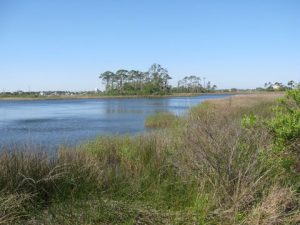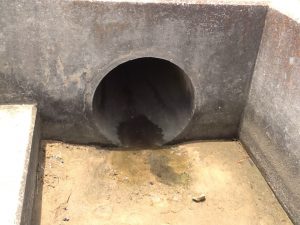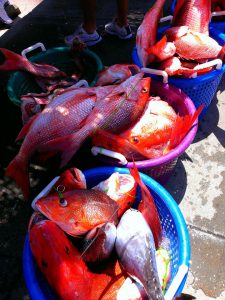What is bioaccumulation of toxins?
Our bodies come in contact, and produce, toxins every day. The production of toxins can result during simple metabolism of food. However, our bodies are designed with a system to rid us of these toxins. Toxins are processed by our immune system and removed via our kidneys. Some chemical compounds are structured in a way that they are not as easily removed, thus they accumulate in our bodies over time, often in fatty tissues, and sometimes they are toxic – this is bioaccumulation.

Photo: Rick O’Connor
Biomagnification takes it a step further. In many cases, the concentrations of bioaccumulating toxic substances in the water may be in low enough concentrations to have little effect on human health. They are ingested by small organisms in the environment, such as plankton or juvenile marine fish, and – again are at low concentrations. However, they are accumulated in their tissues and as the next level of the food chain begin to consume them – they too accumulate the toxic compounds in their tissues. Small fish consume large amounts of plankton and thus, large amounts of the toxins they have accumulated – increasing the concentration within their own tissues. This continues up the food chain to a point where, in the larger predators, the concentrations of these toxins have increased enough that they now pose a threat to human health – this is biomagnification.
The presence, and amount, of any one bioaccumulating compound varies with species, their size, their age, their gender, their life stage, whether they are mobile or not, their diet, and whether the sample included the skin (which is lipid heavy and a common location for accumulated toxins). In the Pensacola Bay System, about 30 species of marine plants and animals have been analyzed for the presence of these accumulating compounds.
Species collected from Pensacola Bay that were analyzed for contaminants
| Plants | 3 species of seagrass
1 species of seaweed Colonized algal periphyton |
| Invertebrates | 4 species of freshwater mussels
Eastern oyster 1 species of brackish water clams 1 species of barnacle Several species of shrimp Blue crab Oyster drill (snail) |
| Vertebrates | 2 species of catfish
5 species of scaienids (drums, croakers, trout) Bluegill Bluefish Several species of flounder 2 species of jacks Largemouth bass Sheepshead Striped mullet |
Trace Metal Accumulation
Much of what has been studied in terms of metal accumulation has come from shellfish – particularly eastern oysters. Ten different metals have been found in oysters with zinc being in the highest concentration and lead the lowest. A 2005 study found that levels of arsenic, lead, and nickel collected from mussels collected at selected locations in the PBS were regionally high (meaning higher than other estuaries in the region). Another study (2003) found that levels of 16 different metals in shellfish were three times higher in Bayou Chico than samples from East Bay. A 1993 study found that organisms attached to pieces of treated wood in Santa Rosa Sound had elevated levels of metals. However, another study (2008) found low concentrations of metals in five species of fish collected in Escambia Bay near the I-10 Bridge.

Photo: Rick O’Connor
The bioaccumulation potential within plants is less understood than animals. That said – concentrations within seagrass were relatively low when compared to the sediments they were growing in and periphytic algae attached to them.
Total Mercury Concentrations (ng/g – dry weight) for Local Marine Organisms
Lewis and Chaney (2008)
| Range (ng/g) | Species |
| 0-200 | Sediments, seagrass, oysters |
| 200 – 400 | Periphytic algae |
| 400 – 600 | Mussels |
| 600 – 800 | Brackish clams, blue crabs |
| 800 and higher | Fish |
The above table shows biomagnification.
Comparing trace metal concentrations between Pensacola Bay and other Regional Estuaries
(USEPA unpublished data)
| Pensacola Bay, Escambia Bay, Escambia River, Bayou Texar, Bayou Chico, Bayou Grande, Santa Rosa Sound | Grand Lagoon (Bay Co.), Mississippi Sound, Old River, Suwannee River, Withlacoochee River, Bay La Launch |
| Cadmium | Higher in PBS; highest in Bayou’s Grande and Texar |
| Chromium | Similar to other estuaries |
| Copper | Slightly elevated in Bayou Chico and Escambia River; highest in Withlacoochee |
| Total Mercury | Much higher in PBS; particularly in the bayous |
| Nickel | Lower in PBS |
| Lead | Higher in PBS; particularly in the bayous |
| Zinc | Higher in PBS; particularly in the bayous |
There are higher concentrations of trace metals in PBS and particularly in the bayous.

Photo: Betsy Walker
Non-Nutrient Organic Chemicals
These are compounds such as PCBs, DDT, and PAHs; many are actually families of multiple forms of compounds. Information on the bioaccumulation of these compounds in PBS is less common than those of trace metals. However, this information is important since they have long half-lives and magnify within the food web.
That said – there are studies on these compounds that go back to the 1970’s. They looked at DDT, pesticides, and PAHs in oysters and croakers. One study (1986-96) found DDT concentrations in oysters at 60 ppb or less. A follow up study (2004-05) at those same locations found concentrations between 8-20 ppb. One study (2008) found the order of accumulating non-nutrient organic compounds with PAHs as the highest and dieldrin at the lowest. Downward trends were reported (2004-05) for many of these compounds including PAHs and PCBs.
Some of these compounds have entered the PBS via unlined ponds associated with on-land Superfund sites. Creosote and pentachlorophenol were stored for years in such ponds and have leached into area waters such as Bayou Chico and portions of upper Pensacola Bay. A study (1987-88) found oyster drills sampled in these areas had concentrations 10x higher than reference sites in other parts of the PBS.
So what can we do about this?
The compounds that are there – are there. Many of these trace metals are heavy and sink into the sediments. There occurrence within the food web has decreased over time and some have suggested the safest thing to do is to leave them where they are. No doubt, any project requiring sediment movement requires much review and permitting.
To try to remove these compounds would be extremely expensive – hence the Superfund Program. So if we cannot clean the sediments without a lot of labor and money, can we reduce the amount that enters the bay today?
Many of these compounds come from industrial processing of products we really want or need. Reduction of the production of some will be difficult, but there is much industry can do to reduce the chance of those compounds reaching our estuaries – and they are doing this. Point source pollution (direct discharge from an industry) has reduced significantly since the 1970’s. Non-point sources (indirect discharge from you and I) is still a problem. We can choose products that contain less (or none) of the compounds we discussed. Following an IPM program for dealing with household and lawn pests (see article on Florida Friendly Yards – https://blogs.ifas.ufl.edu/escambiaco/2018/06/08/restoring-the-health-of-pensacola-bay-what-can-you-do-to-help-a-florida-friendly-yard/) can help a lot. As can practices that reduce the amount of run-off reaching our bays. Reducing your use of lawn watering, using rain barrels, or rain gardens, and planting living shorelines (all mentioned in the FFY article) can certainly help.
Reference
Lewis, M.J., J.T. Kirschenfeld, T. Goodhart. 2016. Environmental Quality of the Pensacola Bay System: Retrospective Review for Future Resource Management and Rehabilitation. U.S. Environmental Protection Agency. Gulf Breeze FL. EPA/600/R-16/169.
 0
0
